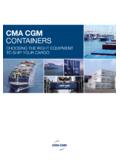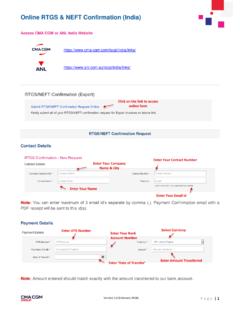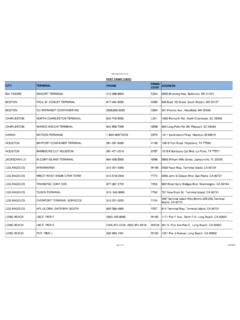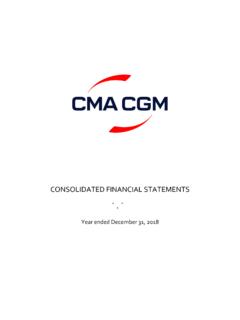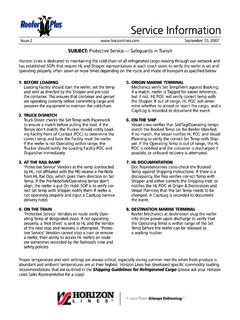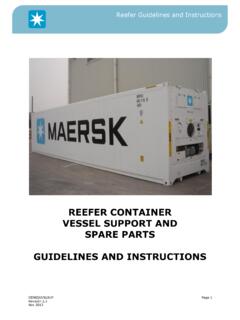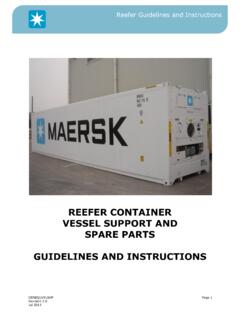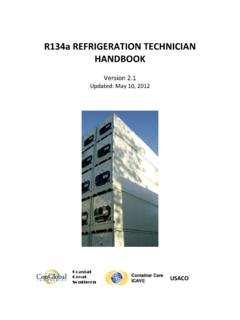Transcription of CARGO SECURING MANUAL FOR M/S TEST VESSEL - CMA …
1 CARGO SECURING MANUAL FOR M/S TEST VESSEL . MODEL MANUAL . FOR GENERAL. CARGO /CONTAINER VESSEL . BY. DET NORSKE VERITAS. This is an example of a CARGO SECURING MANUAL according to guidelines for the Preparation of the CARGO SECURING MANUAL (IMO ) and the Amendments to the Code of Safe Practice for CARGO Stowage and SECURING (IMO ) . Accelerations and SECURING is based on DNV's IMO LASHCONTM, hence it is assumed that the VESSEL have IMO LASHCONTM installed onboard. The latest amendments as per the end of May 2002 are covered in this model MANUAL . Inquiries may be directed to: Det Norske Veritas MTPNO876 Bulk & Container Ships Veritasveien 1. N-1322 H VIK, NORWAY. Telephone: + 47 67 57 99 00. Fax: + 47 67 57 99 11. Version: 1. Date: 04-01-01. Page 1. CARGO SECURING MANUAL FOR M/S TEST VESSEL . CARGO SECURING MANUAL for M/S TEST VESSEL . Page 2. CARGO SECURING MANUAL FOR M/S TEST VESSEL .
2 1 Contents 1 Contents .. 3. 2 4. Ship 4. Definitions .. 5. General 5. Principal sources of 6. 3 SECURING Devices and 7. Specification of Fixed CARGO SECURING Devices.. 7. Specification of Portable CARGO SECURING Devices.. 7. Inspection and Maintenance Schemes .. 8. 4 Stowage and SECURING of CARGO .. 11. Handling and safety 11. General principles of CARGO 11. Safe handling of CARGO SECURING devices .. 12. Evaluation of forces acting on CARGO units .. 12. Forces acting on typical CARGO units .. 14. Calculation of forces in semi- and non-standardised lashing 15. MSLs for different SECURING devices 15. Safety factor 15. Simplified method Rule of thumb 15. Ship Specific Example based on Alternative Method using IMO LASCHONTM 16. Ship Specific Accelerations from IMO LASCHONTM 19. Application of portable SECURING 20. 5 Supplementary Requirements for General CARGO /Container VESSEL .
3 21. Bulk 21. Extracts from various Timber Deck Codes .. 21. Container 36. Handling and Safety Instructions .. 36. Stowage and SECURING Instructions .. 37. Stowage and SECURING Plan (not included in this model MANUAL ) 37. Appendix I Log for maintenance of CARGO SECURING 38. Appendix II MANUAL procedure for calculation of 40. Appendix III Applicable Annexes from the CSS Code .. 51. ANNEX 6 Safe stowage and SECURING of coiled sheet 51. ANNEX 7 Safe stowage and SECURING of heavy metal 53. ANNEX 8 Safe stowage and SECURING of anchor 54. ANNEX 9 Safe stowage and SECURING of metal scrap in bulk .. 55. ANNEX 11 General guidelines for the under-deck stowage of logs .. 56. ANNEX 12 Safe stowing and SECURING of unit 58. Appendix IV LASHCONTM IMO USER GUIDE .. 61. 1 62. 62. System requirements .. 62. User requirements .. 62. 2. User 63. Input 63. Input 65. Calculation 67.
4 Special features of Lashcon 67. Program assumptions .. 67. Appendix V Certification for fixed CARGO SECURING devices .. 69. Appendix VI Certification for portable CARGO SECURING 69. Page 3. CARGO SECURING MANUAL FOR M/S TEST VESSEL . 2 General Ship Data General Data Ship Name: M/S Test VESSEL DNV Id No: 12345. IMO No: 67890123. Flag Flag Class Notation 1A1 General CARGO / Container Carrier Ship dimensions Length, Lpp m Beam, B m Depth moulded, D m Draft, T m Speed, V kn GM, range of values - m Reference documents Document/ MANUAL Issue date Approval date Loading MANUAL Trim & Stability Booklet Page 4. CARGO SECURING MANUAL FOR M/S TEST VESSEL . Definitions CARGO SECURING Devices is all fixed and portable devices used to secure and support CARGO units. Maximum SECURING Load (MSL) is a term used to define the allowable load capacity for a device used to secure CARGO to a ship.
5 Safe Working Load (SWL) may be substituted for MSL for SECURING purposes, provided this is equal to or exceeds the strength defined by MSL. Standardized CARGO means CARGO for which the ship is provided with an approved SECURING system based upon CARGO units of specific types. Semi-standardized CARGO means CARGO for which the ship is provided with a SECURING system capable of accommodating a limited variety of CARGO units, such as vehicles, trailers, etc. Non-standardized CARGO means CARGO which requires individual stowage and SECURING arrangements. CARGO transport unit means a road freight vehicle, a railway freight wagon, a freight container, a road tank vehicle, a railway tank wagon or a portable tank. Fixed SECURING Devices means SECURING points and supports either integral, welded into the hull structure, or non-integral, welded onto the hull structure.
6 Portable SECURING Devices means portable devices used for lashing, SECURING or support of CARGO units. General Information 1 The guidance given herein should by no means rule out the principles of good seamanship, neither can they replace experience in stowage and SECURING practice. 2 The information and requirements set forth in this MANUAL are consistent with the requirements of the VESSEL 's trim and stability booklet, International Load Line Certificate (1966), the hull strength loading MANUAL (if provided) and with the requirements of the International Maritime Dangerous Goods (IMDG) Code (if applicable). 3 This CARGO SECURING MANUAL specifies arrangements and CARGO SECURING devices provided on board the ship for the correct application to and the SECURING of CARGO units, containers, vehicles and other entities, based on transverse, longitudinal and vertical forces which may arise during adverse weather and sea conditions.
7 4 It is imperative to the safety of the ship and the protection of the CARGO and personnel that the SECURING of the CARGO is carried out properly and that only appropriate SECURING points or fittings should be used for CARGO SECURING . 5 The CARGO SECURING devices mentioned in this MANUAL should be applied so as to be suitable and adapted to the quantity, type of packaging, and physical properties of the CARGO to be carried. When new or alternative types of CARGO SECURING devices are introduced, the CARGO SECURING MANUAL should be revised accordingly. Alternative CARGO SECURING devices introduced should not have less strength than the equipment which it replaces. 6 There should be a sufficient quantity of reserve CARGO SECURING devices on board the ship. Page 5. CARGO SECURING MANUAL FOR M/S TEST VESSEL . 7 Information on the strength and instructions for the use and maintenance of each specific type of CARGO SECURING device, where applicable, is provided in this MANUAL .
8 The CARGO SECURING devices should be maintained in a satisfactory condition. Items worn or damaged to such an extent that their quality is impaired should be replaced. Principal sources of danger Some important sources of danger which can affect the safety of roll on/roll off ships and of persons on them include: 1. CARGO badly stowed or inadequately secured inside or on CARGO units. 2. Free surface effects in tank vehicles, tank containers or other bulk units which are slack. 3. Poorly maintained ramps, lifts and stern doors. 4. Poorly maintained or inadequately illuminated decks. 5. Wet decks. 6. Failure to apply brakes correctly. 7. Insufficient or incorrectly applied lashings or the use of lashing equipment of the wrong type or of inadequate strength with respect to mass and centre of gravity of the CARGO unit and the weather conditions likely to be encountered during the voyage.
9 Page 6. CARGO SECURING MANUAL FOR M/S TEST VESSEL . 3 SECURING Devices and Arrangements When SECURING devices are replaced, the inventory lists should, as far as practicable, be updated and relevant certificates inserted in an appropriate place in the MANUAL . Specification of Fixed CARGO SECURING Devices. No other attachments to the ship hull structure than those listed below shall be made without the Masters special permission. Any lashing arrangements imposing loads exceeding the maximum SECURING loads listed in the inventory list may cause serious structural damage. Fixed SECURING devices: Type Manufacturer Type Quantity MSL [kN]] Sketch designation D-Rings Lord of the D-562 18 150 Not included D-Rings in this Model MANUAL Twistlock Container TW-16-22 48 250 Not included foundation SECURING AS in this Model MANUAL Specification of Portable CARGO SECURING Devices.
10 As a general rule-of-thumb, if doubt about determining the MSL, portable equipment should not be subject to loads exceeding what have been customary usage in the past. Portable SECURING devices: Type Manufacturer Type Quantity MSL [kN] Sketch designation Lashing Chain Chain Chain B14804 15 x 2 m Not included in this Model MANUAL Twistlock Container TW-1-C 112 250 Not included SECURING AS in this Model MANUAL Turnbuckle Container TB-15-N 48 250 Not included SECURING AS in this Model MANUAL Lashing bar Container LB-6-P 48 250 Not included SECURING AS in this Model MANUAL Page 7. CARGO SECURING MANUAL FOR M/S TEST VESSEL . Inspection and Maintenance Schemes Regular inspections and maintenance are carried out under the responsibility of the Master. CARGO SECURING device inspections should as a minimum include: 1. Routine visual examinations of components being utilised: - Before using any CARGO SECURING device, whether fixed or portable, the equipment must be visually inspected to ensure that there are no defects and that when appropriate, all moving parts have been greased and are operating correctly.
